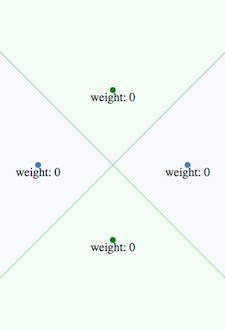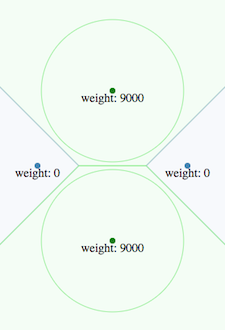d3-weighted-voronoi
This d3 plugin produces a weighted Voronoi diagram. It tessellates/partitions the plane given a set of weighted two-dimensional sites.
Because a picture is worth a thousand words:
Available only for d3 v4, d3 v5 and d3 v6.
This plugin is at the root of:
- the d3-voronoi-map plugin, which computes a one-level Voronoï-based treemaps
- the d3-voronoi-treemap plugin, which computes a multi-level Voronoï-based treemaps,
- the d3-voronoi-map-tween plugin, which allows animation between two d3-voronoi-map.
Context
Compared to the default Voronoï diagram, it adds the capability to assign a particular weight to each site. The higher is the weight of a site, the more this site influences its environment, and the larger is its surrounding area.
Weighted Voronoï diagrams come in severall flavours (additive/multiplicative, powered/not-powered, 2D/3D and higher dimensions, ..., cf. Wikipedia). This plugin focuses on the 2D additive weighted power diagram, which provides a tessellation made of convex hole-free polygons/cells with straight borders, as the default Voronoï diagram does.
Nonetheless, weighted Voronoï diagrams may have weird properties compared to default Voronoï diagrams:
- a site may be outside it's zone of influence (ie. computed polygon)
- a site may have no zone of influence
These situations arise when some sites are overweighted by others. You can experiment it in Voronoï playground : interactive weighted Voronoï study.
Examples
Installing
If you use NPM, npm install d3-weighted-voronoi. Otherwise, load https://rawcdn.githack.com/Kcnarf/d3-weighted-voronoi/v1.1.3/build/d3-weighted-voronoi.js (or its d3-weighted-voronoi.min.js version) to make it available in AMD, CommonJS, or vanilla environments. In vanilla, a d3 global is exported:
<script src="https://d3js.org/d3.v6.min.js"></script>
<script src="https://rawcdn.githack.com/Kcnarf/d3-weighted-voronoi/v1.1.3/build/d3-weighted-voronoi.js"></script>
<script>
var weightedVoronoi = d3.weightedVoronoi();
</script>If you're interested in the latest developments, you can use the master build, available throught:
<script src="https://raw.githack.com/Kcnarf/d3-weighted-voronoi/master/build/d3-weighted-voronoi.js"></script>TL;DR;
In your javascript, in order to define the tessellation:
var weightedVoronoi = d3.weightedVoronoi()
.x(function(d){ return xScale(d); } // set the x coordinate accessor
.y(function(d){ return yScale(d); } // set the y coordinate accessor
.weight(function(d){ return weightScale(d); } // set the weight accessor
.clip([[0,0], [0,height], [width, height], [width,0]]) // set the clipping polygon
var cells = weightedVoronoi(data); // compute the weighted Voronoi tessellationThen, later in your javascript, in order to draw cells:
d3.selectAll('path')
.data(cells)
.enter()
.append('path')
.attr('d', function (d) {
return cellLiner(d) + 'z';
});Reference
- Computing Voronoi Treemaps - Faster, Simpler, and Resolution-independent , section 4.4
- (part of) https://github.com/ArlindNocaj/power-voronoi-diagram for a Java implementation
API
# d3.weightedVoronoi()
Creates a new weightedVoronoi with the default x-, y-, weight- accessors, and clip, extent, size configuration values.
# weightedVoronoi(data)
Computes the weighted Voronoi diagram for the specified data points.
Returns a sparse array of polygons clipped to the clip polygon, one for each cell (each unique input point) in the diagram. Each polygon is represented as an array of points [x, y] where x and y are the point coordinates, a site field that refers to its site (ie. with x, y and weight retrieved from the original data), and a site.originalObject field that refers to the corresponding element in data. Polygons are open: they do not contain a closing point that duplicates the first point; a triangle, for example, is an array of three points. Polygons are also counterclockwise (assuming the origin ⟨0,0⟩ is in the top-left corner).
Note that weighted Voronoï diagrams may have weird properties compared to default Voronoï diagrams:
- a site may be outside it's zone of influence (ie. computed polygon)
- a site may have no zone of influence
These situations arise when some sites are overweighted by others. You can experiment it in Voronoï playground : interactive weighted Voronoï study.
# weightedVoronoi.x([x])
If x is specified, sets the x-coordinate accessor. If x is not specified, returns the current x-coordinate accessor, which defaults to:
function x(d) {
return d.x;
}# weightedVoronoi.y([y])
If y is specified, sets the y-coordinate accessor. If y is not specified, returns the current y-coordinate accessor, which defaults to:
function y(d) {
return d.y;
}# weightedVoronoi.weight([weight])
If weight is specified, sets the weight accessor. If weight is not specified, returns the current weight accessor, which defaults to:
function weight(d) {
return d.weight;
}# weightedVoronoi.clip([clip])
If clip is specified, sets the clipping polygon, compute the adequate extent and size, and returns this layout. clip must define a hole-free concave polygon, and must be specified as an array of 2D points [x, y], which must be (i) open (no duplication of the first D2 point) and (ii) counterclockwise (assuming the origin ⟨0,0⟩ is in the top-left corner). If clip is not specified, returns the current clipping polygon, which defaults to:
[
[0, 0],
[0, 1],
[1, 1],
[1, 0],
];# weightedVoronoi.extent([extent])
If extent is specified, it is a convenient way to define the clipping polygon as a rectangle. It sets the extent, computes the adequate clipping polygon and size, and returns this layout. extent must be a two-element array of 2D points [x, y], which defines the clipping polygon as a rectangle with the top-left and bottom-right corners respectively set to the first and second points (assuming the origin ⟨0,0⟩ is in the top-left corner on the screen). If extent is not specified, returns the current extent, which is [[minX, minY], [maxX, maxY]] of current clipping polygon, and which defaults to:
[
[0, 0],
[1, 1],
];# weightedVoronoi.size([size])
If size is specified, it is a convenient way to define the clipping polygon as a rectangle. It sets the size, computes the adequate clipping polygon and extent, and returns this layout. size must be a two-element array of numbers [width, height], which defines the clipping polygon as a rectangle with the top-left corner set to [0, 0]and the bottom-right corner set to [width, height](assuming the origin ⟨0,0⟩ is in the top-left corner on the screen). If size is not specified, returns the current size, which is [maxX-minX, maxY-minY] of current clipping polygon, and which defaults to:
[1, 1];Dependencies
- d3-array.extent
- d3-polygon.{polygonHull, polygonLenght}
Semantic Versioning
d3-weighted-voronoi attempts to follow semantic versioning and bump major version only when backwards incompatible changes are released.

